July 4, 2019
After leaving Savusavu, we headed to Volivoli Point (the double names continue) where there is a fabulous diving resort run by the same family (probably from New Zealand) for the past 25 years or so.
We toured around the area, sampling several swimming locations, and then anchored near Aurora B by the Volivoli Dive Resort. We had dinner the first night and booked a tour of a waterfall the next day. Joe stayed behind to get his hip massaged and have a rest day. Aurora B sent Henry and Eva with us to keep all the kids happy.
Soni (pronounced Sony), our tour guide, was very knowledgeable about Fiji and presented the information just how I wanted it. Of all the tours we have been on, his was the best for information about a country in a way that was easy to understand.
He is passionate about his country and its 91% land ownership by native Fijians. He says 6% is owned by the government and 3% by non-natives. Soni is one of the first people I’ve spoken to in the world that says his government is doing a good job. Based on all the things I saw, it seems like he is right. They have made education free for all and give bus passes to the kids so they can get to school. They build shelters along the roads so people can sell their fruit and vegetables in comfort. When families started moving to cities so their young people could go to high schools (there weren’t any in rural areas), the government built boarding schools for the kids close to their rural villages so the kids can go to school and visit their families on holidays without totally disrupting the village life. They also give full college scholarships to high school students that earn top scores on the national test. These students have to continue to earn good grades in college. Other students that go on to college can get government loans to pay for their education.
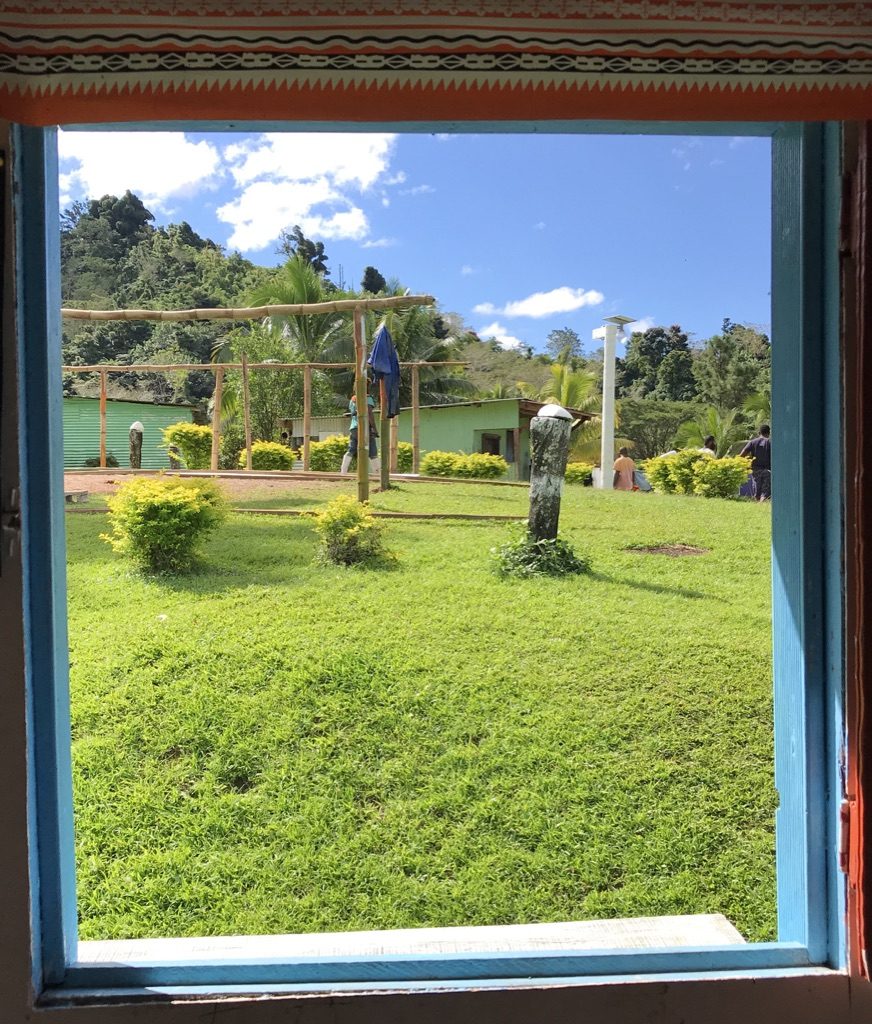
So we learned a lot about Fiji in our 1.5 hour ride to the village that owns the land with the waterfall on it. I will do my best to sum up some of the things Soni told us but I have not verified any of this information with any other source and I may not have remembered or correctly set forth all that he said. So, trust but verify, please.
All of the native-owned land in Fiji is tribe-owned and can be leased to foreigners for up to 99 years. So, for example, the company that produces Fiji water is owned by an American, but they pay rent on the land. That rent goes to a government agency which distributes it to the tribe. The land agency holds quite a bit of power in Fiji but they also appear to help ensure that the tribes get a good deal on their leases. When we arrived in the village, we went to a communal building where our guide did sevusevu with the chief’s oldest son. We arranged the tour at the last minute so the chief couldn’t be there.

The village was in the midst of “Village Week” when all the residents (maybe 100?) turned out to clean, repair, and maintain the village. People were cutting grass, working on houses, airing out blankets, etc. They told us that next week is “Home Week” when they will do similar projects on their houses. Throughout our day with Soni, he emphasized that Fijians like to be with each other and live with their friends and family. They prefer this to anything else. He said they will never be good at running businesses because, if a Fijian ran a store and his friends came in and wanted things at the store, he would feel guilty charging them for the things so he would soon go out of business. There are lots of Indians living in Fiji and Soni said that while there aren’t tensions with the Indians, the Fijians don’t have a lot in common with them because the Indians are all about “money, money, money.” He said the Indians prefer to live by themselves and indicated their individual homes, set apart from each other, as contrasted to the Fijian neighborhoods. Soni added that the Fijians don’t have much need for money although he did say that the villages have fundraisers each year. These fundraisers raise money from villagers who have moved away or from those who have gone overseas (he specifically mentioned to play rugby) and send money back. This money gets sent to the chief and his councilors who divide the money between the school, village needs, and the young people who are attending college so they can have some spending money.
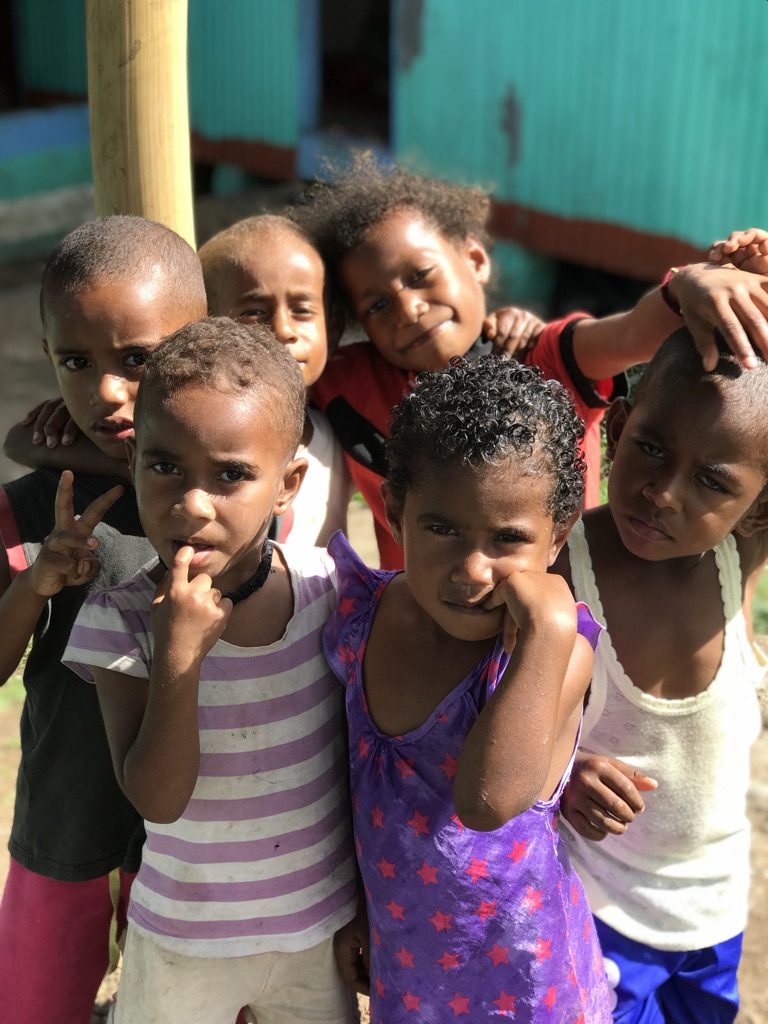
It’s definitely different than how our family lives in the US. I’m guessing we are more like the Indians. It’s a very appealing system in many ways and is probably more how our country used to function with our native American tribes. Each Fijian village has a chief and the chiefs are part of a regional council who have representatives at the district level. There are 14 districts in Fiji. Soni said that if there is an issue in a village that can’t be solved, it gets sent up the chain to eventually reach the district level. At this level, the government ministers attend the council of chiefs and so they work together to solve problems. The most recent government has disbanded this council of chiefs and many Fijians are unhappy about this.
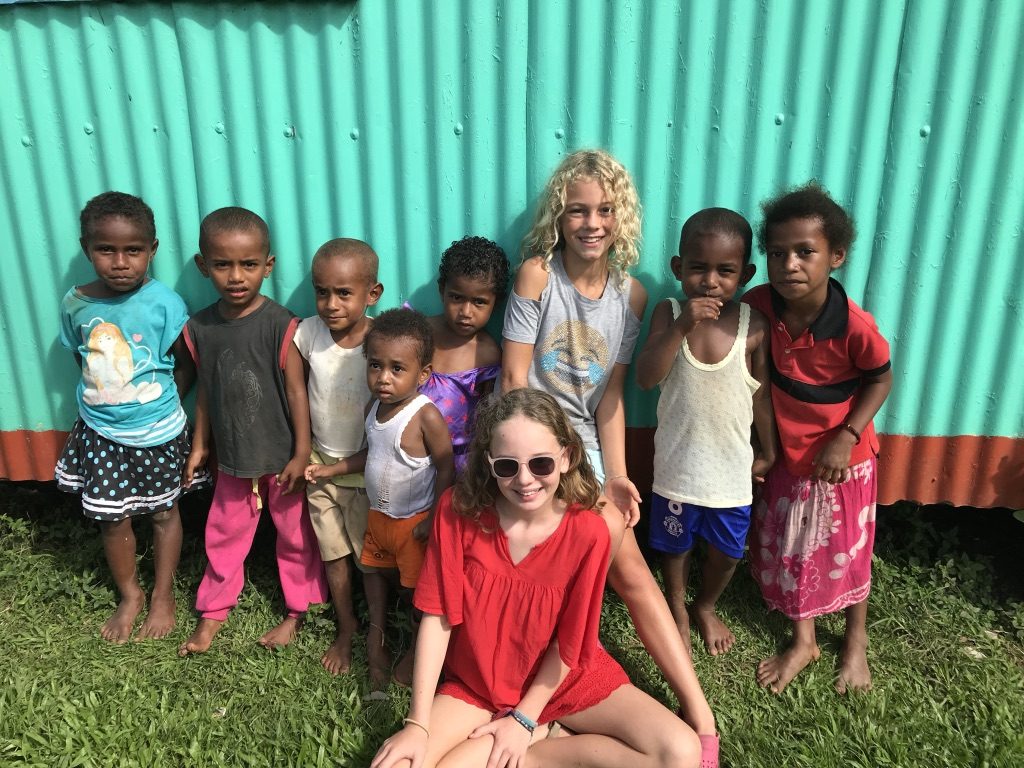
Via the sevusevu ceremony (Soni gave some token to the chief’s son and he chanted and clapped over it), we obtained permission to go to the waterfall. Soni also paid the village for the guides that took us (he stayed behind) and for the lunch they gave us. The walk to the waterfall passed through jungly hills, over a bridge (where Tully and Cobin reenacted the Billy Goats Gruff) and past fields newly hewn out of the foliage to grow cava. The waterfall itself was stunning and we had a good time admiring it. The guides took the willing in our group behind the waterfall which was akin to walking across wet rocks on tap shoes during a torrential rainstorm. It was wet, cold, and exciting. The entire time we were traversing the side of the cliff, the guides kept ululating to hear the echos, because they were excited, to put us on edge? We’re not sure but it added to the chaos and commotion. After we managed to exit the falls, we dove into the pool and swam back across to where the younger kids were waiting with our other guides.

After we returned to the village, we had hot lemon tea with lots of sugar and served ourselves off a buffet table laden with rice, multiple dishes of vegetables cooked in a variety of ways, and one bowl of chicken’s feet in broth. I skipped the chicken’s feet. I like my adventure outside of the dining arena.
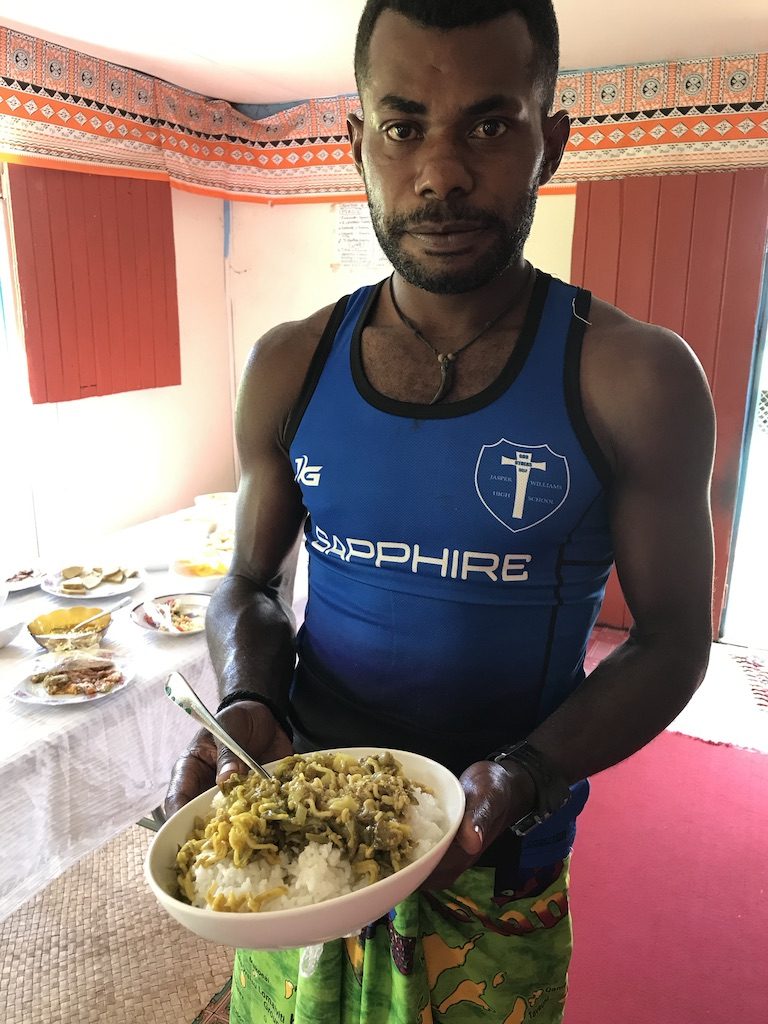
Soni led us out of the village and we returned the borrowed lengths of cloth that all but the youngest children had to wear as skirt or kilts to cover our knees. All the men in the village wear these garments, called sulus, much like the men in Tonga. When we left the village for the waterfall hike, all of us, including our guides, took them off and left them in a small hut, then put them back on before re-entering the village.
After our return to the resort, Soni drove us into town in his daughter’s Toyota Prius so we could get more cash and buy a few things for the boat. I asked why there are so many Priuses around and he said that Japan sends them lots of secondhand cars to buy. Sure enough, all the console buttons were in Japanese. Shannon wisely pointed out that the Japanese must drive on the left side of the road (as all the countries have done since Niue) because the driver’s seat is on the right in the car Soni was driving. Sure enough, she was correct. There’s an interesting article online about why Japan, like Britain and her former colonies, drives on the left. I’ll let you find it if you’re interested.
Today we celebrated the Fourth by going sailing and snorkeling. We made cheeseburgers as well as our traditional “flag in the cake” cake. The cake did double duty as a birthday cake for Shannon. Poor thing had a birthday on the 29th of June. She and her parents left the US on a flight on June 28 at 11 PM and crossed the international date line so when they arrived on June 30, her birthday had come and gone somewhere in the middle. So she got to blow out some candles a few days late.
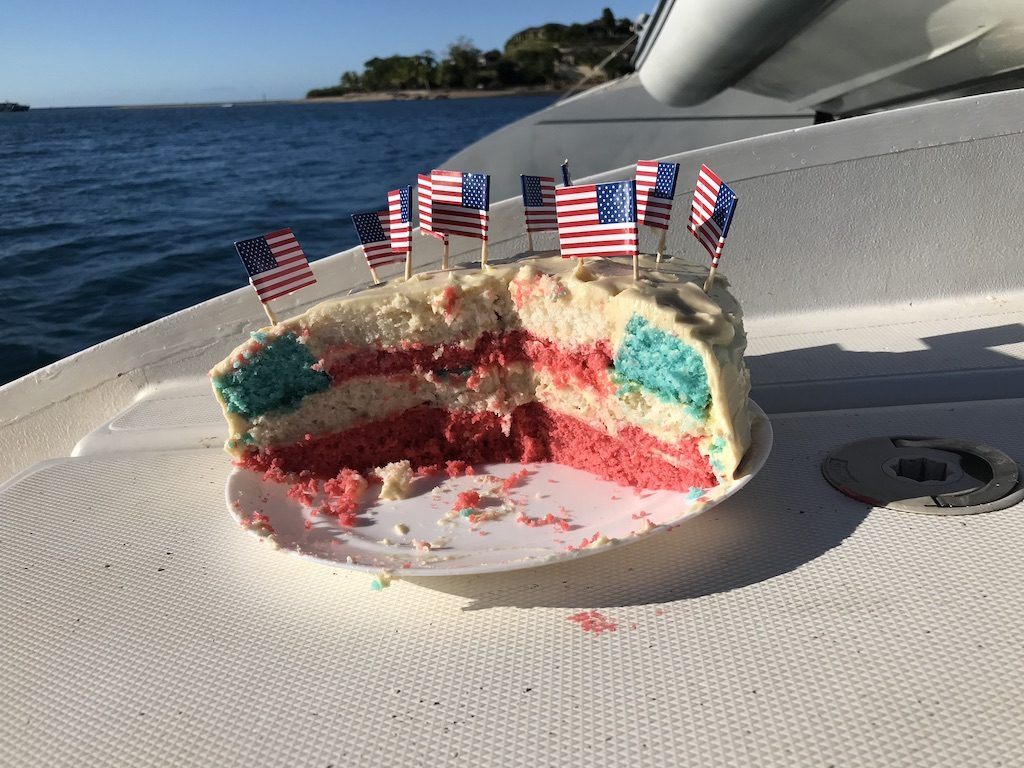
Despite their being English, and therefore, as Shannon said, “the enemy of the Fourth,” we joined Aurora B for Lovo night at the resort we are anchored next to. This is a traditional meal when they cook various meats underground and also have a dance performance. All of it was great but the big surprise was that after the spear dance and bonfire, the master of ceremonies (our friend Soni), wished all the Americans a Happy Fourth and then they set off a fireworks show for us, right on the beach! It was one of the best fireworks shows I’ve been to, mainly because it was unexpected and didn’t involve any of the normal fireworks preparation activities like driving, parking, waiting, getting eaten by bugs, etc. We just looked up into the sky and watched. Then it was over and we didn’t have to fight traffic to get home. Delightful!
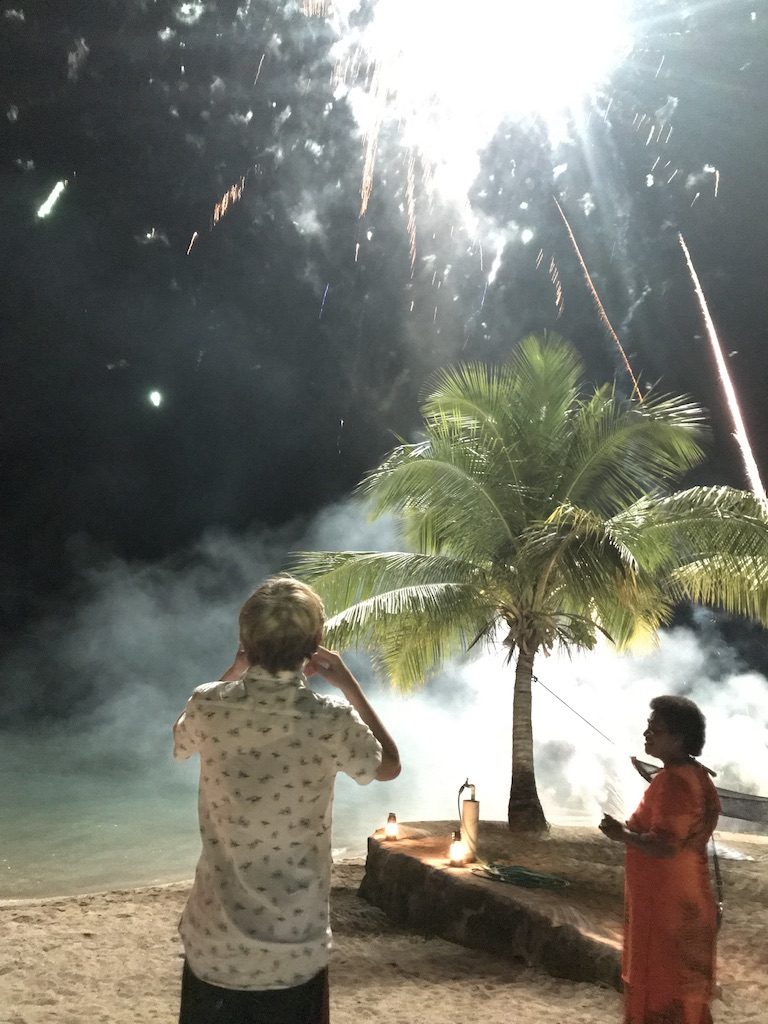
Thanks to Aunt Sharon and Kay for the great 4th of July paraphernalia. The kids enjoyed putting all their gear on and decorating the cake with red, white and blue!

